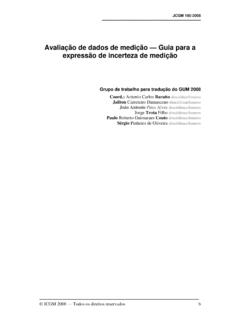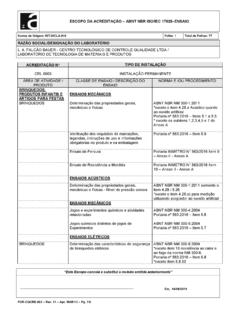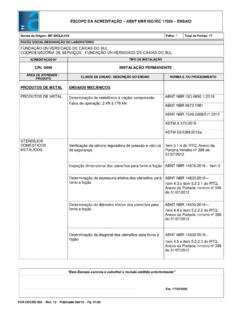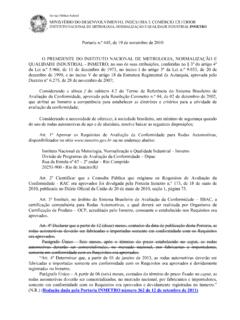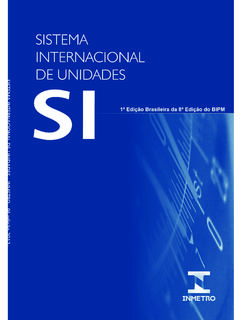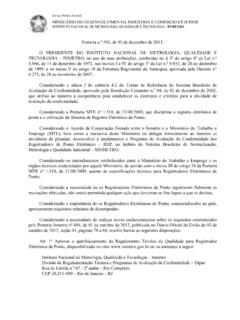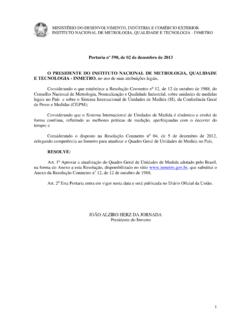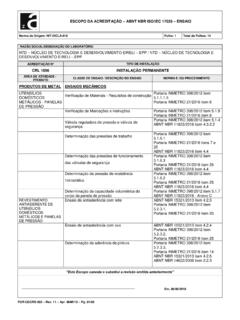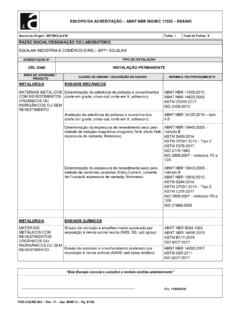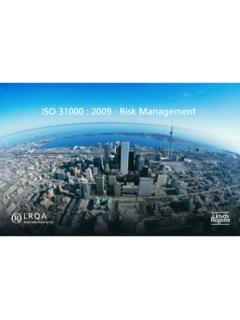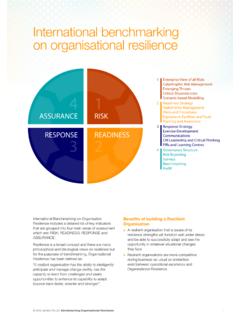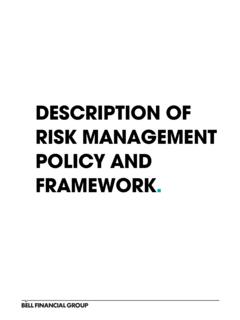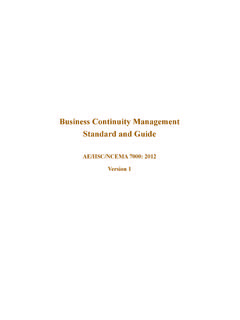Transcription of ISO 31000:2009; ISO/IEC 31010 & ISO Guide 73:2009 ...
1 ISO 31000 : 2009 ; ISO/IEC 31010 & ISO Guide 73: 2009 International Standards for the Management of Risk Kevin W Knight AM; CPRM; Hon FRMIA; FIRM (UK); LMRMIA. CHAIRMAN ISO PROJECT COMMITTEE 262 - RISK MANAGEMENT MEMBER STANDARDS AUSTRALIA / STANDARDS NEW ZEALAND JOINT TECHNICAL COMMITTEE OB/7 - RISK MANAGEMENT P 0 BOX 226, NUNDAH Qld 4012, Australia E-mail: 03/12 We all manage risk consciously or unconsciously - but rarely systematically Managing risk means forward thinking Managing risk means responsible thinking Managing risk means balanced thinking Managing risk is all about maximising opportunity and minimising threats The risk management process provides a framework to facilitate more effective decision making Managing Risk The Pivotal Definition risk effect of uncertainty on objectives NOTE 1 An effect is a deviation from
2 The expected positive and/or negative. NOTE 2 Objectives can have different aspects (such as financial, health and safety, and environmental goals) and can apply at different levels (such as strategic, organization-wide, project, product and process). NOTE 3 Risk is often characterized by reference to potential events and consequences, or a combination of these. NOTE 4 Risk is often expressed in terms of a combination of the consequences of an event (including changes in circumstances) and the associated likelihood of occurrence.
3 NOTE 5 Uncertainty is the state, even partial, of deficiency of information related to, understanding or knowledge of, an event, its consequence, or likelihood. [ISO Guide 73: 2009 ] risk owner person or entity with the accountability and authority to manage a risk control measure that is modifying risk NOTE 1 Controls include any process, policy, device, practice, or other actions which modify risk. NOTE 2 Controls may not always exert the intended or assumed modifying effect. [ISO Guide 73: 2009 ] Accountable Responsible Liability for the outcomes of actions or decisions NOTE: Includes failure to act or make decisions OR being obligated to answer for a decision OR obligation to answer for an action.
4 _____ Obligation to carry out duties or decisions, or control over others as directed OR having the obligation to act OR obligation to carry out instructions. Yet to be defined Corporate Governance The way in which an organisation is governed and controlled in order to achieve its objectives. The control environment makes an organisation reliable in achieving these objectives within a tolerable degree of risk. It is the glue which holds the organisation together in pursuit of its objectives while risk management provides the resilience.
5 Queensland Audit Office Report No. 7 1998- 99: - Mandate and Commitment ( ) Implementing risk Management ( ) Design of framework ( ) Continual improvement of the Framework ( ) Monitoring and review of the Framework ( ) Framework (Clause 4) a) Creates value b) Integral part of organizational processes c) Part of decision making d) Explicitly addresses uncertainty e) Systematic, structured and timely f) Based on the best available information g) Tailored h)
6 Takes human and cultural factors into account i) Transparent and inclusive j) Dynamic, iterative and responsive to change k) Facilitates continual improvement and enhancement of the organization Principles (Clause 3) Process (Clause 5) Establishing the context ( ) Risk treatment ( ) Risk identification ( ) Risk analysis ( ) Risk evaluation ( ) Risk assessment ( ) M o n i t o r i n g & r e v i e w ( ) C o m u n i c a t i o n & c o n s u l t a t i o n AS/NZS ISO 31000 : 2009 Figure 1 Relationship between the principles, framework and process Business Principles Approach AS/NZS ISO 31000 .
7 2009 Principles (Clause 3) Risk management value an integral part of organisational processes part of decision making address uncertainty systematic and structured based on the best available information tailored into account human factors transparent and inclusive dynamic, iterative and responsive to change capable of continual improvement and enhancement Risk management should create value RM contributes to the achievement of objectives. Protects value minimise downside risk, protects people, systems and processes.
8 Risk management should be an integral part of organizational processes RM is not a stand-alone activity from the management system of the organisation. RM is part of the process - not an additional compliance task. Risk management should be part of decision making Risk management helps decision makers make informed choices, prioritize actions and distinguish among alternative courses of action. Helps allocate scarce resources. Risk management explicitly addresses uncertainty Risk management explicitly takes account of uncertainty, the nature of that uncertainty, and how it can be addressed.
9 RM addresses uncertainty, no matter the level of uncertainty. Risk management should be systematic and structured A systematic, timely and structured approach to the management of risk contributes to efficiency and to consistent, comparable and reliable results. The more aligned the more effective and efficient. Risk management should be based on the best available information The inputs to the process of managing risk are based on information sources such as historical data, experience, stakeholder feedback, observation, forecasts and expert judgement.
10 Information costs money. Perfect information is not always possible. Start with resources/expertise you have or gain easily. Increase information as the level of risk increases. Risk management should be tailored Risk management is aligned with the organization's external and internal context and risk profile. Different risk appetites & different measurements. Context remains one of the most difficult areas. Risk management should take into account human factors The management of risk recognizes the capabilities, perceptions and intentions of people that make every organisation different.

